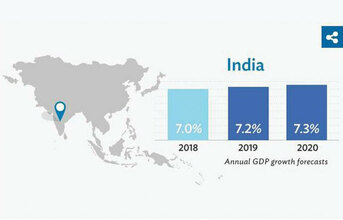
Recent policy measures by the government to improve the investment climate and boost private consumption and investment will help India to lift economic growth in the next two fiscal years, according to a new report from the Asian Development Bank (ADB).
In its Asian Development Outlook (ADO) 2019, ADB projects gross domestic product (GDP) growth in India to rise to 7.2% in fiscal year (FY) 2019 and reach 7.3% in FY2020, reversing two years of declining growth as reforms to improve the business and investment climate take effect. India's fiscal year starts on 1 April and ends 31 March of the next calendar year. ADO is ADB's annual flagship economic publication.
"India will remain one of the fastest-growing major economies in the world this year given strong household spending and corporate fundamentals," said ADB Chief Economist, Yasuyuki Sawada. "India has a golden opportunity to cement recent economic gains by becoming more integrated in global value chains. The country's young workforce, an improving business climate, and a renewed focus on export expansion all support this."
Income support to farmers, hikes in procurement prices for food grains, and tax relief to tax payers earning less than INR 500,000 ($7,212) will boost household income. Declining fuel and food prices are also expected to provide an impetus for consumption. An increase in utilization of production capacity by firms, along with falling levels of stressed assets held by banks and easing of credit restrictions on certain banks, is expected to help investment grow at a healthy rate.
Downside risks to growth include a higher-than-expected moderation in global demand and a potential escalation of trade tensions. Lower-than-targeted tax revenues or a delay in strengthening bank and corporate balance sheets could also undermine economic expansion.
Consumer price inflation is expected to rise to 4.3% in FY2019 and 4.6% in FY2020 as food costs increase slightly and domestic demand strengthens. Given that inflation is expected to average around 4.0% in the first half of FY2019, the central bank would have some room for lowering policy rates.
Imports are expected to rise mainly due to stronger domestic demand while a growth slowdown in India's key export destinations would dent export growth. The current account deficit is expected to widen a bit to 2.4% of GDP in FY2019 and 2.5% of GDP in FY2019. The deficit is expected to be financed comfortably by capital flows, given that India has emerged as an attractive destination for foreign investment.
A key factor driving India's persistent current account deficit is its tepid export performance compared to other East and Southeast Asian economies. India's export performance could benefit from greater participation in global value chains (GVCs). Lower trade costs, improved infrastructure quality, and enhanced worker skills could help India integrate more with GVCs. Global experience suggests that enhanced GVC participation is also associated with other development goals that India strives to achieve such as higher economic growth, an increase in the share of manufacturing in GDP, and faster job creation.
END



























